Optimal Planning of Electric Vehicle Charging Station Considering Mutual Benefit of Users and Power Grid
Abstract
:1. Introduction
- (1)
- An optimal electric vehicle charging station location and capacity model is proposed, which considers the mutual benefit of users and the power grid.
- (2)
- Based on the Voronoi diagram and improved particle swarm optimization (IPSO), a solution model is developed to determine location, capacity, and service area of each charging station. The remainder of this paper is organized as follows. Section 2 presents the forecasting model of EV’s fast charging demand. Section 3 presents the location and capacity model of EV charging stations. Section 4 gives the solution method. Section 5 conducts case studies to verify the effectiveness of the proposed method. Section 6 summarizes the paper.
2. Forecasting of EV’s Fast Charging Demand
3. Location and Capacity Model
3.1. Location Model
3.2. Capacity Model
4. Solution of Model
- Step 1: Forecast the number of EVs at each fast charging demand point according to (1).
- Step 2: Randomly generate charging stations’ locations in the planning area, and use the locations of charging stations as the positions of particles.
- Step 3: Taking the position of particle as the growing point, then use Voronoi diagram to divide the service area of each charging station. Use (10) to determine the capacity of charging station.
- Step 4: Calculate the annual construction and operation cost of charging station, the annual loss cost of users on the way to the charging station, and the annual network loss cost of power grid respectively according to (3), (4), (5), and (6). Then use (2) to calculate the annual social cost of charging station and take it as the value of particle. Finally, find the individual optimal value and the global optimal value and use the penalty function to deal with the particles that do not meet the constraints.
- Step 5: Determine whether reach the maximum number of iterations. If not, go to step 6, otherwise go to step 7.
- Step 6: Update the speed and position of particles, go to step 3 and the number of iterations plus one.
- Step 7: Output each charging station’s optimal location and its service area, the planning costs, and the number of chargers in each charging station.
5. Case Study and Discussion
5.1. Case Description
5.2. Simulation Analysis and Discussion
5.3. Comparison of Different Method
6. Conclusions
Author Contributions
Funding
Data Availability Statement
Conflicts of Interest
References
- Luo, L.Z.; Gu, W.; Zhou, S.Y.; Huang, H.; Gao, S.; Han, J.; Wu, Z.; Dou, X.B. Optimal planning of electric vehicle charging stations comprising multi-types of charging facilities. Appl. Energy 2018, 226, 1087–1099. [Google Scholar] [CrossRef]
- Yao, W.F.; Zhao, J.H.; Wen, F.S.; Dong, Z.Y.; Xue, Y.S.; Xu, Y.; Meng, K. A Multi-Objective Collaborative Planning Strategy for Integrated Power Distribution and Electric Vehicle Charging Systems. IEEE Trans. Power Syst. 2014, 29, 1811–1821. [Google Scholar] [CrossRef]
- Kong, W.W.; Luo, Y.G.; Feng, G.X.; Li, K.Q.; Peng, H.E. Optimal location planning method of fast charging station for electric vehicles considering operators, drivers, vehicles, traffic flow and power grid. Energy 2019, 186, 115826. [Google Scholar] [CrossRef]
- Zhou, B.; Chen, G.; Huang, T.W.; Song, Q.K.; Yuan, Y.F. Planning PEV Fast-Charging Stations Using Data-Driven Distributionally Robust Optimization Approach Based on phi-Divergence. IEEE Trans. Transp. Electrif. 2020, 6, 170–180. [Google Scholar] [CrossRef]
- Liu, Z.P.; Wen, F.S.; Ledwich, G. Optimal Planning of Electric-Vehicle Charging Stations in Distribution Systems. IEEE Trans. Power Deliv. 2013, 28, 102–110. [Google Scholar] [CrossRef]
- Aghapour, R.; Sepasian, M.S.; Arasteh, H.; Vahidinasab, V.; Catalao, J.P.S. Probabilistic planning of electric vehicles charging stations in an integrated electricity-transport system. Electr. Power Syst. Res. 2020, 189, 106698. [Google Scholar] [CrossRef]
- Zheng, Y.; Dong, Z.Y.; Xu, Y.; Meng, K.; Zhao, J.H.; Qiu, J. Electric Vehicle Battery Charging/Swap Stations in Distribution Systems: Comparison Study and Optimal Planning. IEEE Trans. Power Syst. 2014, 29, 221–229. [Google Scholar] [CrossRef]
- Andrenacci, N.; Ragona, R.; Valenti, G. A demand-side approach to the optimal deployment of electric vehicle charging stations in metropolitan areas. Appl. Energy 2016, 182, 39–46. [Google Scholar] [CrossRef]
- Zeng, B.; Dong, H.Q.; Sioshansi, R.; Xu, F.Q.; Zeng, M. Bilevel Robust Optimization of Electric Vehicle Charging Stations with Distributed Energy Resources. IEEE Trans. Ind. Appl. 2020, 56, 5836–5847. [Google Scholar] [CrossRef]
- Xu, Q.S.; Cai, T.T.; Liu, Y.J.; Yao, L.Z.; Zeng, P.L. Location planning of charging stations for electric vehicles based on drivers’ behaviours and travel chain. Autom. Electr. Power Syst. 2016, 40, 59–65. [Google Scholar]
- Fu, F.J.; Fang, Y.X.; Dong, H.Z.; Chen, W.F. Optimized allocation of charging stations for electric vehicles based on historical trajectories. Autom. Electr. Power Syst. 2018, 42, 72–80. [Google Scholar]
- Simorgh, H.; Doagou-Mojarrad, H.; Razmi, H.; Gharehpetian, G.B. Cost-based optimal siting and sizing of electric vehicle charging stations considering demand response programmes. IET Gener. Transm. Distrib. 2018, 12, 1712–1720. [Google Scholar] [CrossRef]
- Liu, Z.F.; Zhang, W.; Wang, Z.L. Optimal planning of charging station for electric vehicle based on quantum PSO algorithm. Proc. CSEE 2012, 32, 39–45. [Google Scholar]
- Cai, Z.L.; Shu, H.C. Long-term development scale and charging load forecasting of electric vehicle. In Proceedings of the International Conference on Renewable Energy and Environmental Technology (REET 2013), Jilin, China, 21–22 September 2013; pp. 3194–3200. [Google Scholar]
- Xiong, H.; Xiang, T.Y.; Rong, X.; Chen, H.K. Optimal allocation of electric vehicle battery swap stations. Electr. Power Autom. Equip. 2012, 32, 1–6. [Google Scholar]
- Xiong, H.; Xiang, T.Y.; Zhu, Y.G.; Song, X.D.; Chen, H.; Chen, H.K. Electric vehicle public charging stations location optimal planning. Autom. Electr. Power Syst. 2012, 36, 65–70. [Google Scholar]
- Ai, X.; Li, Y.Z.; Wang, K.Y.; Hu, J.J. Locating and sizing of electric vehicle charging station based on chaotic simulated annealing particle swarm optimization algorithm. Electr. Power Autom. Equip. 2018, 38, 9–14. [Google Scholar]
- Bao, Y. Study on Site Selection of Electric Vehicle Charging Stations in Dalian. Master’s Thesis, Dalian Jiaotong University, Dalian, China, 2018. [Google Scholar]
- Zhao, B.Y.; Chen, J.H.; Guo, J.T.; Chen, Y.P.; Zhang, Z.X. Location and capacity of electric vehicle charging station based on Voronoi diagram and improved gravity search algorithm. J. Guangdong Univ. Technol. 2021, 38, 72–78. [Google Scholar]
- Tian, M.Y.; Tang, B.; Yang, X.; Xia, X.Y. Planning of Electric Vehicle Charging Stations Considering Charging Demands and Acceptance Capacity of Distribution Network. Power Syst. Technol. 2021, 45, 498–506. [Google Scholar]
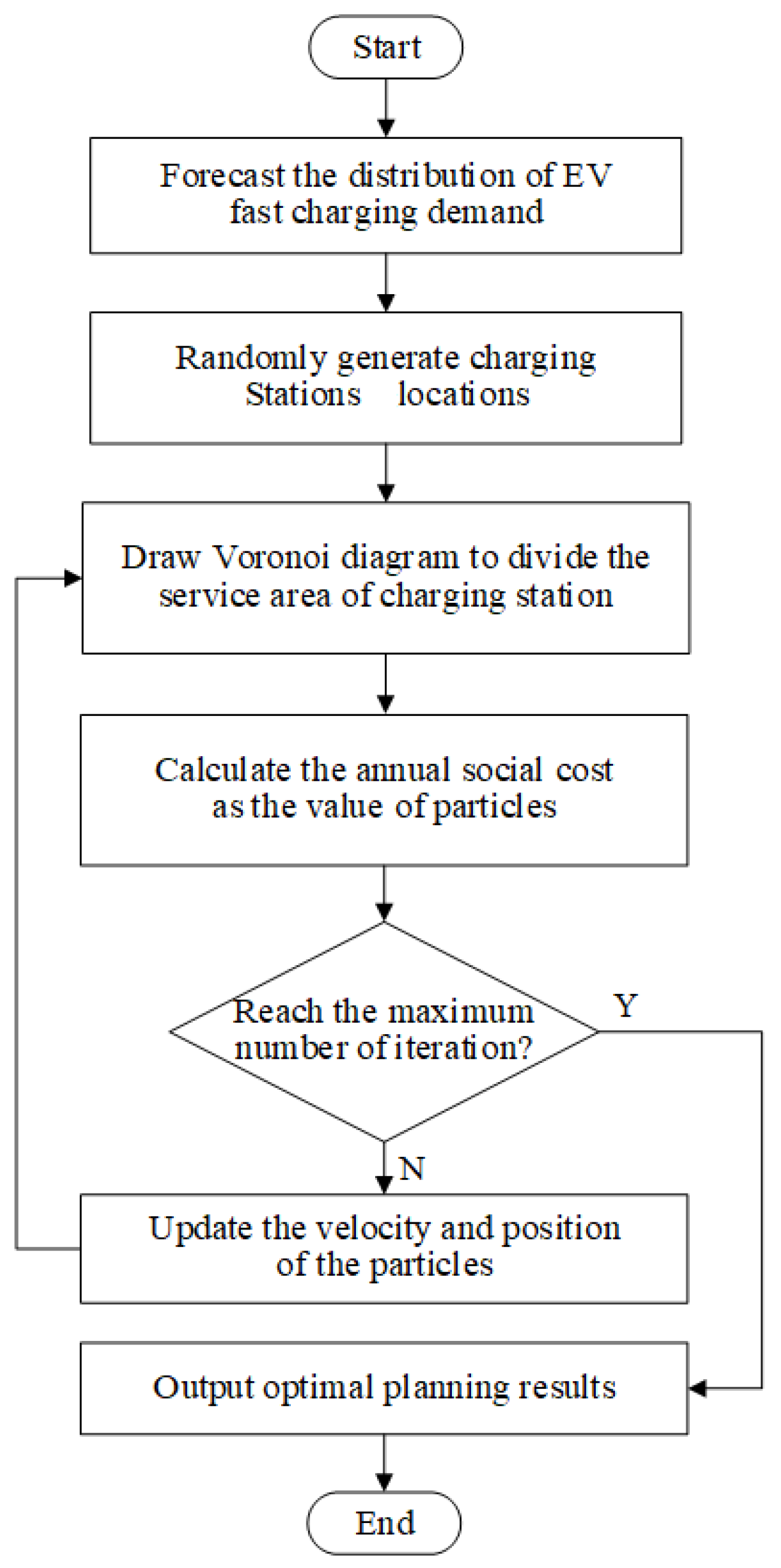
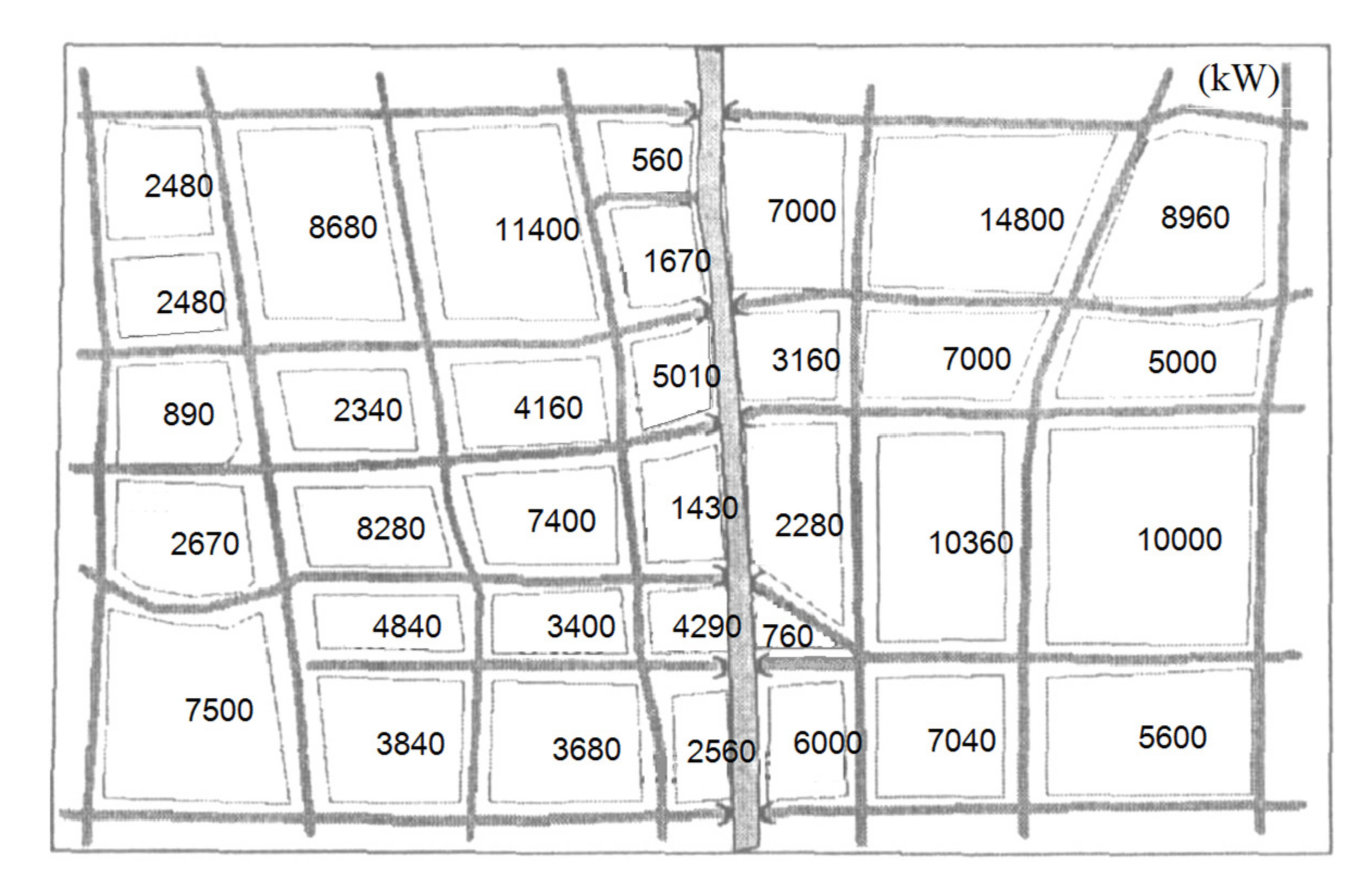
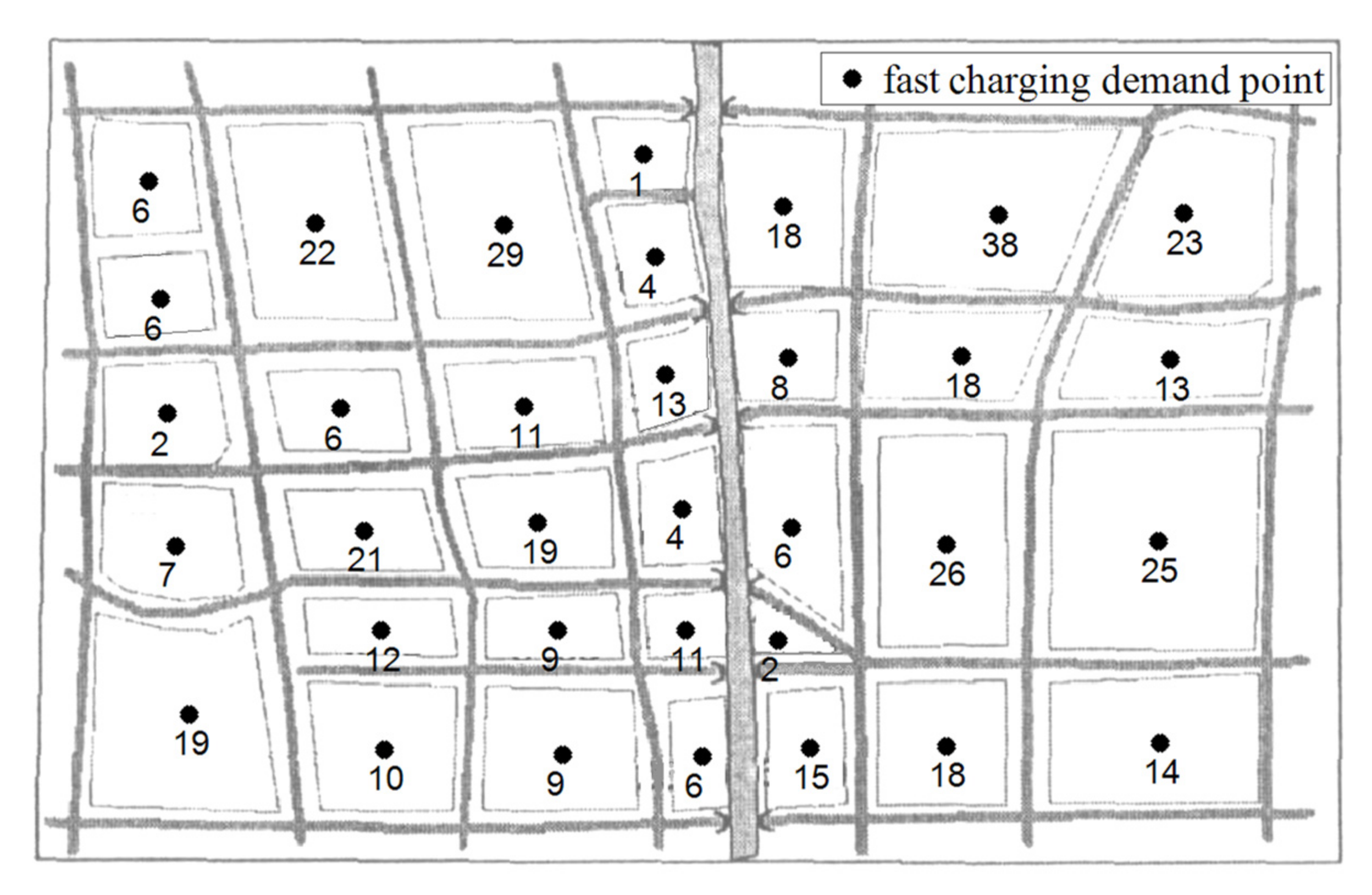
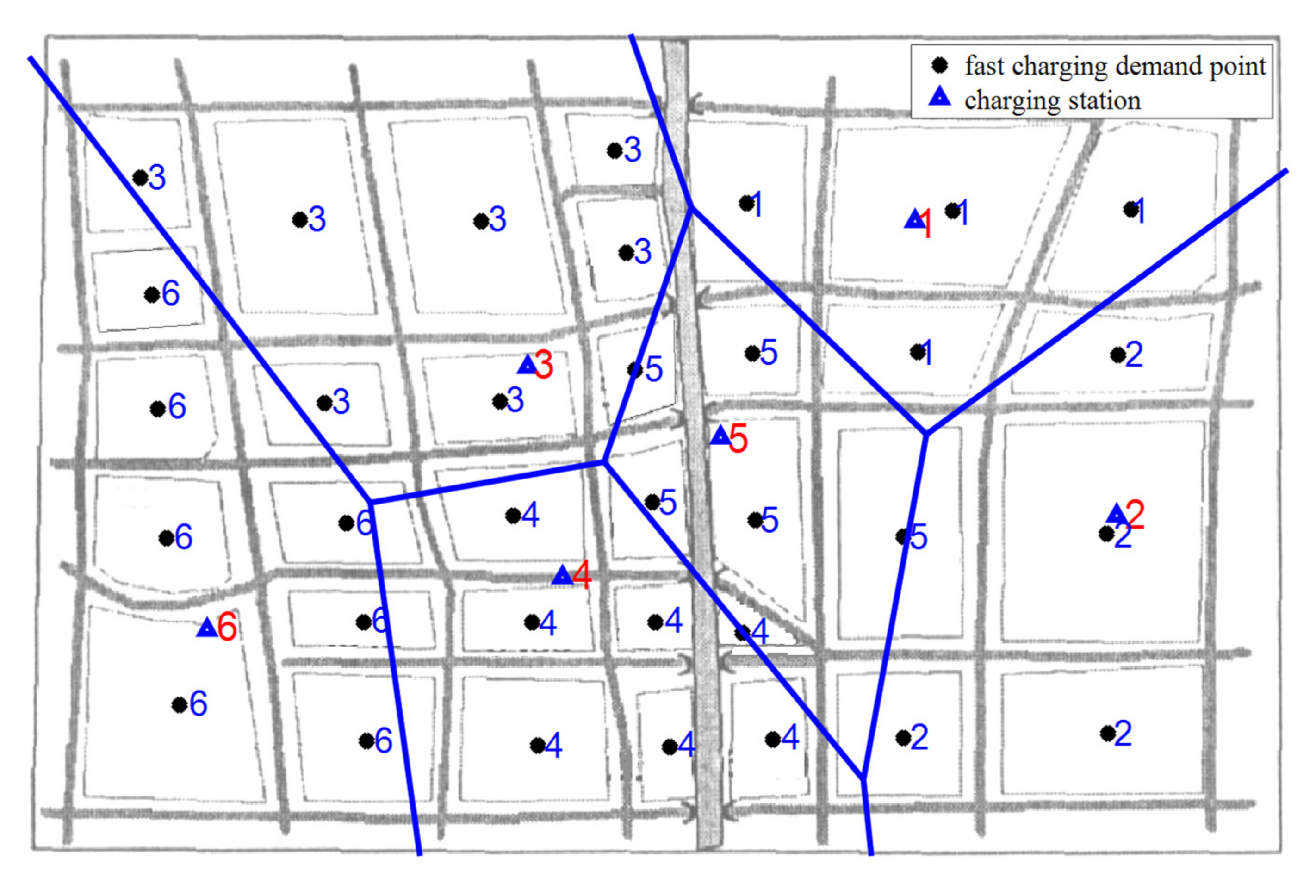
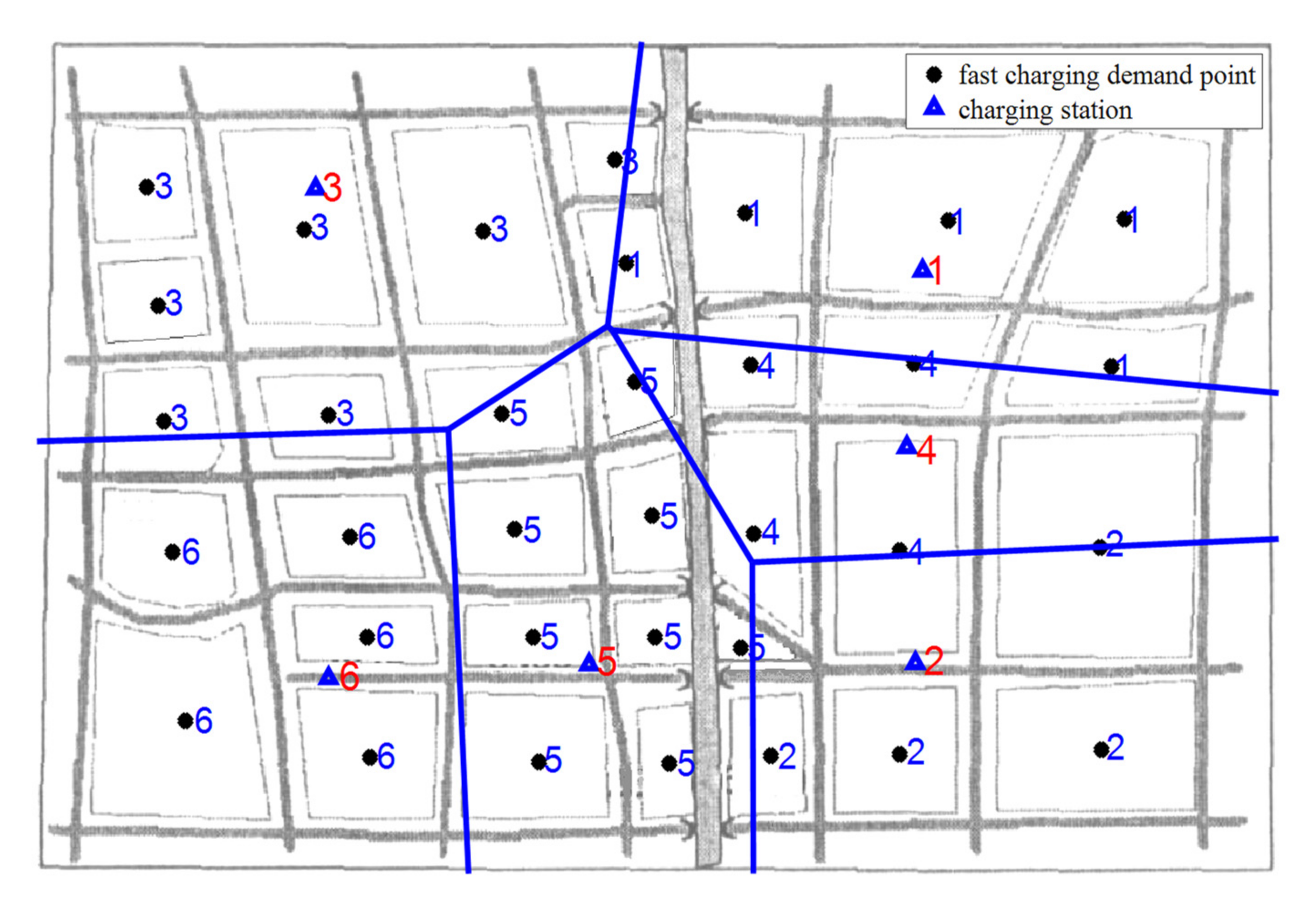
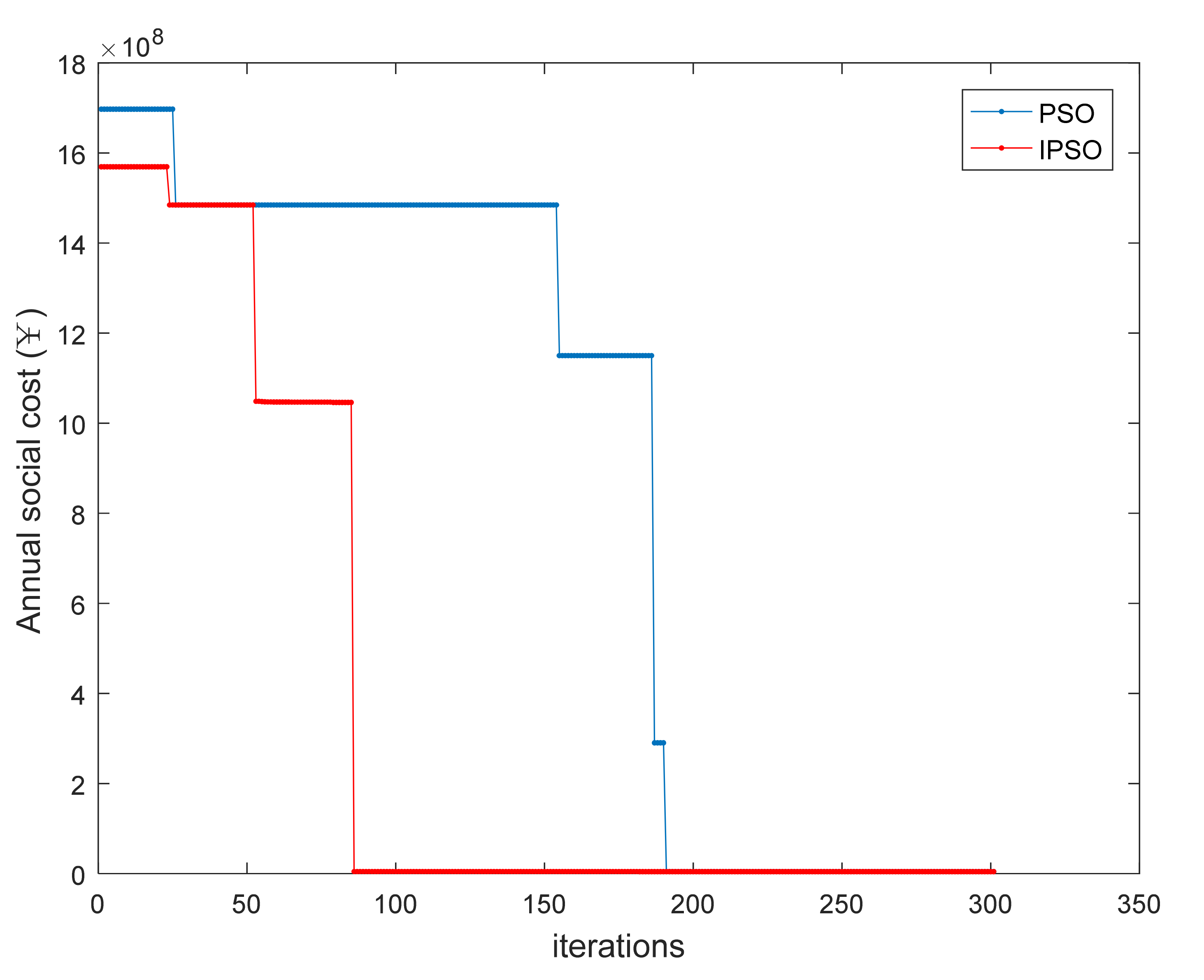
| Charging Station No. | Number of Chargers | Number of EVs in Its Service Area | Annual Construction and Operation Cost (×104 ¥) | Annual Loss Cost of Users (×104 ¥) | Annual Network Loss Cost (×104 ¥) |
|---|---|---|---|---|---|
| 1 | 19 | 97 | 97.98 | 0.45 | 1.74 |
| 2 | 14 | 70 | 66.07 | 0.41 | 1.31 |
| 3 | 16 | 79 | 77.77 | 0.58 | 1.46 |
| 4 | 14 | 71 | 66.07 | 0.38 | 1.31 |
| 5 | 11 | 57 | 51.13 | 0.32 | 1.04 |
| 6 | 15 | 77 | 71.74 | 0.46 | 1.39 |
| Algorithm | Number of Chargers in Each Charging Station | Annual Social Cost (×104 ¥) | Annual Construction and Operation Cost (×104 ¥) | Annual Loss Cost of Users (×104 ¥) | Annual Network Loss Cost (×104 ¥) |
|---|---|---|---|---|---|
| PSO | 19,14,14, 12,17,14 | 446.93 | 436.08 | 2.48 | 8.38 |
| IPSO | 19,14,16, 14,11,15 | 441.59 | 430.75 | 2.59 | 8.25 |
| Methods | Method 1 [3] | Method 2 [20] | Proposed Method |
|---|---|---|---|
| Objectives | Construction cost + power loss cost of vehicle + time loss cost of driver | Construction cost + operating profit | Construction and operation cost + loss cost of users + network loss cost |
| Algorithm /Platform | Universal simulation platform | Genetic algorithm /MATLAB | IPSO + Voronoi diagram/MATLAB |
| Results | Optimal location and size of charging station | Optimal location and size of charging station | Optimal location, capacity, and service area of charging station |
Publisher’s Note: MDPI stays neutral with regard to jurisdictional claims in published maps and institutional affiliations. |
© 2021 by the authors. Licensee MDPI, Basel, Switzerland. This article is an open access article distributed under the terms and conditions of the Creative Commons Attribution (CC BY) license (https://creativecommons.org/licenses/by/4.0/).
Share and Cite
Hou, H.; Tang, J.; Zhao, B.; Zhang, L.; Wang, Y.; Xie, C. Optimal Planning of Electric Vehicle Charging Station Considering Mutual Benefit of Users and Power Grid. World Electr. Veh. J. 2021, 12, 244. https://doi.org/10.3390/wevj12040244
Hou H, Tang J, Zhao B, Zhang L, Wang Y, Xie C. Optimal Planning of Electric Vehicle Charging Station Considering Mutual Benefit of Users and Power Grid. World Electric Vehicle Journal. 2021; 12(4):244. https://doi.org/10.3390/wevj12040244
Chicago/Turabian StyleHou, Hui, Junyi Tang, Bo Zhao, Leiqi Zhang, Yifan Wang, and Changjun Xie. 2021. "Optimal Planning of Electric Vehicle Charging Station Considering Mutual Benefit of Users and Power Grid" World Electric Vehicle Journal 12, no. 4: 244. https://doi.org/10.3390/wevj12040244
APA StyleHou, H., Tang, J., Zhao, B., Zhang, L., Wang, Y., & Xie, C. (2021). Optimal Planning of Electric Vehicle Charging Station Considering Mutual Benefit of Users and Power Grid. World Electric Vehicle Journal, 12(4), 244. https://doi.org/10.3390/wevj12040244







